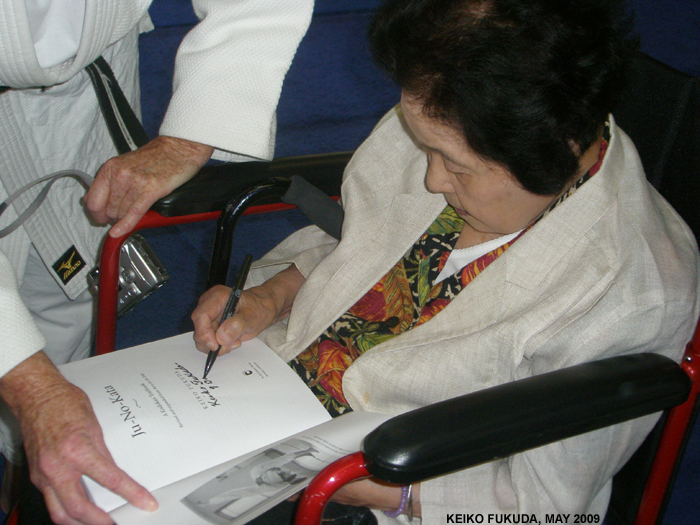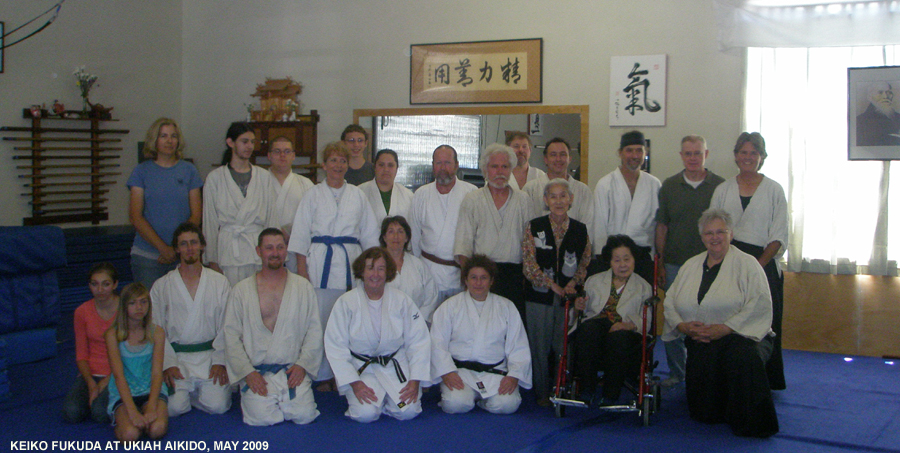copyright © 2009 Janet Rosen, all
rights reserved
On Saturday, May 23, 2009 the Ukiah Aikido dojo rang with the joyful noise of sixteen students gathered for a special training led by Gayle Fillman Sensei. After a little over an hour, Fillman clapped twice and everybody dashed to line up in rank order and bow as a small, slender woman was escorted inside.

The visitor was Keiko Fukuda. The highest ranked woman in judo, with a 9th degree black belt, at 96 Fukuda is a still active and vital link to both the roots of judo and Japan’s samurai era. Her grandfather, Hachinosuke Fukuda, was an instructor of Tenjin Shinyo-ryu Jujutsu. One of his students was Jigoro Kano, the founder of judo; the elder Fukuda was a mentor to Kano and there are Tenjin Shinyo-ryu movements in some of the kata developed by Kano.
In 1935, the 22-year-old Keiko Fukuda was pursuing studies typical for a young lady of the era: ikebana, chado, and shodo. Because of her family background, Kano invited her to come study judo at his school. Judo quickly became the center of her life. She trained with Kano (and is today his last living direct student) as well as with well-known instructors like Kyuzo Mifune. She was a good friend of Shoji Nishio in those days, and remembers when Nishio was invited by Kano to go train in aikido with Morehei Ueshiba as part of an exhange of students between the arts.
In 1990, in a celebration in San Francisco, the Japanese government honored her with the Order of the Sacred Treasure, 4th class. The United States Judo Federation awarded her a red belt in 2001- one of only three - for lifelong contributions and in 2006 at the annual Kagami Biraki, she received her 9th degree black belt at the Kodokan Judo Institute.
Fukuda first visited the United States in 1953, and moved here permanently in 1966 when Mills College in Oakland offered her a teaching position. She has been teaching at her own San Francisco club, the Soko Joshi Judo Club, since 1973. It was here in the early 1980s that Gayle Fillman encountered her by chance “just walking down the street in my neighborhood! I saw these women throwing each other and wanted to see what they were doing.” Fillman had already been training in aikido for many years and was an established aikido instructor in Ukiah. But there was something compelling about the training she watched at the judo club. It was not easy to join - “they turned me down at first, because of my committment to aikido” - but her sincerity impressed them and over time the two women formed a deep friendship.
Over the years, Fukuda has visited Ukiah Aikido many times. The older judoka has served as a mentor and sounding board for Fillman. Fillman and her students have long been a source of practical and emotional support to her, so there is a very special link between this esteemed visitor, her school in San Francisco, and our small rural dojo. On this recent visit, accompanied by a couple of her devoted students, she enjoyed watching Fillman’s students engage in spirited aiki-jo and jo tori practice, whirling and throwing each other with long wooden staffs. Then the group bowed out, bowed once again to Fukuda, and sat around her chair while she shared her thoughts on judo and life. She summarized them as “be strong, be gentle, be beautiful,” then elaborated on the theme.
She described “strong” as having a strong mind and body, with the essential attitude that no matter what kind of day one is having, it is important to show up and train. She described “gentle” as “soft” in the sense of not fighting with or hurting your training partner, and in contrasting “judo” with the older “jujutsu” remarked upon her own slowly evolving understanding of the term “ju.” Finally she addressed the importance of having a “beautiful mind,” or as we might put it, “heart,” for she spoke movingly of the need to help fellow humans in life.

Hanging on the wall at Ukiah Aikido is a large calligraphy, done many years ago by Fukuda as a gift for Fillman and the dojo. When asked about the peice, Fukuda translated the words of her teacher, Jigoro Kano, “maximum efficiency with minimum effort.” Despite the surface differences between aikido and judo, this is an approach they share, along with promoting harmony and applying the philosophy of the art in daily life. As Keiko Fukuda expresses it in her full motto, “Be gentle, kind, and beautiful, yet firm and strong, in mind, body and spirit.”
On Saturday, May 23, 2009 the Ukiah Aikido dojo rang with the joyful noise of sixteen students gathered for a special training led by Gayle Fillman Sensei. After a little over an hour, Fillman clapped twice and everybody dashed to line up in rank order and bow as a small, slender woman was escorted inside.

The visitor was Keiko Fukuda. The highest ranked woman in judo, with a 9th degree black belt, at 96 Fukuda is a still active and vital link to both the roots of judo and Japan’s samurai era. Her grandfather, Hachinosuke Fukuda, was an instructor of Tenjin Shinyo-ryu Jujutsu. One of his students was Jigoro Kano, the founder of judo; the elder Fukuda was a mentor to Kano and there are Tenjin Shinyo-ryu movements in some of the kata developed by Kano.
In 1935, the 22-year-old Keiko Fukuda was pursuing studies typical for a young lady of the era: ikebana, chado, and shodo. Because of her family background, Kano invited her to come study judo at his school. Judo quickly became the center of her life. She trained with Kano (and is today his last living direct student) as well as with well-known instructors like Kyuzo Mifune. She was a good friend of Shoji Nishio in those days, and remembers when Nishio was invited by Kano to go train in aikido with Morehei Ueshiba as part of an exhange of students between the arts.
In 1990, in a celebration in San Francisco, the Japanese government honored her with the Order of the Sacred Treasure, 4th class. The United States Judo Federation awarded her a red belt in 2001- one of only three - for lifelong contributions and in 2006 at the annual Kagami Biraki, she received her 9th degree black belt at the Kodokan Judo Institute.
Fukuda first visited the United States in 1953, and moved here permanently in 1966 when Mills College in Oakland offered her a teaching position. She has been teaching at her own San Francisco club, the Soko Joshi Judo Club, since 1973. It was here in the early 1980s that Gayle Fillman encountered her by chance “just walking down the street in my neighborhood! I saw these women throwing each other and wanted to see what they were doing.” Fillman had already been training in aikido for many years and was an established aikido instructor in Ukiah. But there was something compelling about the training she watched at the judo club. It was not easy to join - “they turned me down at first, because of my committment to aikido” - but her sincerity impressed them and over time the two women formed a deep friendship.
Over the years, Fukuda has visited Ukiah Aikido many times. The older judoka has served as a mentor and sounding board for Fillman. Fillman and her students have long been a source of practical and emotional support to her, so there is a very special link between this esteemed visitor, her school in San Francisco, and our small rural dojo. On this recent visit, accompanied by a couple of her devoted students, she enjoyed watching Fillman’s students engage in spirited aiki-jo and jo tori practice, whirling and throwing each other with long wooden staffs. Then the group bowed out, bowed once again to Fukuda, and sat around her chair while she shared her thoughts on judo and life. She summarized them as “be strong, be gentle, be beautiful,” then elaborated on the theme.
She described “strong” as having a strong mind and body, with the essential attitude that no matter what kind of day one is having, it is important to show up and train. She described “gentle” as “soft” in the sense of not fighting with or hurting your training partner, and in contrasting “judo” with the older “jujutsu” remarked upon her own slowly evolving understanding of the term “ju.” Finally she addressed the importance of having a “beautiful mind,” or as we might put it, “heart,” for she spoke movingly of the need to help fellow humans in life.

Hanging on the wall at Ukiah Aikido is a large calligraphy, done many years ago by Fukuda as a gift for Fillman and the dojo. When asked about the peice, Fukuda translated the words of her teacher, Jigoro Kano, “maximum efficiency with minimum effort.” Despite the surface differences between aikido and judo, this is an approach they share, along with promoting harmony and applying the philosophy of the art in daily life. As Keiko Fukuda expresses it in her full motto, “Be gentle, kind, and beautiful, yet firm and strong, in mind, body and spirit.”